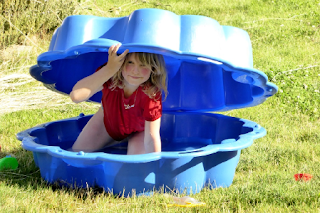1) Extend your child's vocabulary of position words
 Whether you are the hider or the seeker, make sure that in the delight of finding or being found you don't forget to talk about where you were found. This is an opportunity to emphasise position words e.g. 'under the table' 'behind the curtains'
Whether you are the hider or the seeker, make sure that in the delight of finding or being found you don't forget to talk about where you were found. This is an opportunity to emphasise position words e.g. 'under the table' 'behind the curtains'
2) Use the same words over and over
This is especially important for little ones: Use the same repeated language over and over again: 'Where are you? Coming, ready or not!' When your children hear this over and over again, not only are they learning the phrase for themselves but they are getting extra exposure to the rules and grammar of language.
3) Give a running commentary
When you are doing the finding give a running commentary of where your child is not, to help them learn sentences with negatives 'she's not on these cushions' 'he's not behind this door'
4) Be creative with what you hide
You can play hide and seek with other objects too. Hide a teddy in a cupboard, hide a spoon in a vase, hide a shoe behind the curtains.... It's a great opportunity to model more complex sentences to your child 'look, the cup was under the cushions!'
5) Which way are you counting?
Give your child a countdown when you are on your way to find him 'I'm going to find you in 1 2 3 4 5......' If your child is just learning the words to count to 10 then make sure you count up to 10 before your find her; when you are learning the sequence of counting up to 10 it is not helpful to start hearing it backwards! If your child has mastered counting to 10 then you can start counting down to 0.
 Whether you are the hider or the seeker, make sure that in the delight of finding or being found you don't forget to talk about where you were found. This is an opportunity to emphasise position words e.g. 'under the table' 'behind the curtains'
Whether you are the hider or the seeker, make sure that in the delight of finding or being found you don't forget to talk about where you were found. This is an opportunity to emphasise position words e.g. 'under the table' 'behind the curtains'2) Use the same words over and over
This is especially important for little ones: Use the same repeated language over and over again: 'Where are you? Coming, ready or not!' When your children hear this over and over again, not only are they learning the phrase for themselves but they are getting extra exposure to the rules and grammar of language.
3) Give a running commentary
When you are doing the finding give a running commentary of where your child is not, to help them learn sentences with negatives 'she's not on these cushions' 'he's not behind this door'
4) Be creative with what you hide
You can play hide and seek with other objects too. Hide a teddy in a cupboard, hide a spoon in a vase, hide a shoe behind the curtains.... It's a great opportunity to model more complex sentences to your child 'look, the cup was under the cushions!'
5) Which way are you counting?
Give your child a countdown when you are on your way to find him 'I'm going to find you in 1 2 3 4 5......' If your child is just learning the words to count to 10 then make sure you count up to 10 before your find her; when you are learning the sequence of counting up to 10 it is not helpful to start hearing it backwards! If your child has mastered counting to 10 then you can start counting down to 0.

0 comments: